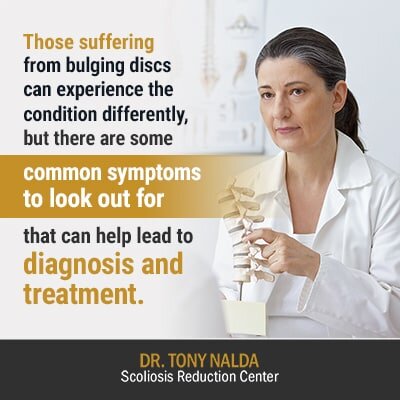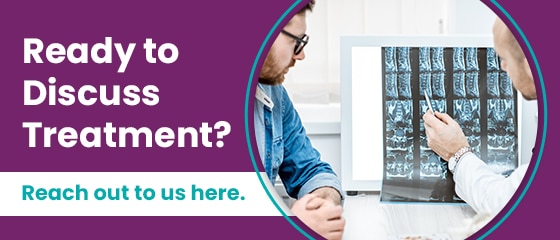The C5-C6 vertebrae are located in the lower portion of the cervical spine (upper back and neck). The role of the intervertebral discs is to provide cushioning between the individual vertebra of the spine, to help evenly distribute force throughout the spine, and to facilitate spinal flexibility. When the C5-C6 disc is compromised, so too is the natural and healthy cervical curvature.
The spine is made up of three natural and healthy curves. When looking at it from the side, the spine takes a soft ‘S’ shape. When one of those curves is lost, adverse spinal tension is introduced, causing numerous problems. Let’s first start exploring C5-C6 disc bulging by looking at the curves that make up a healthy spine and what happens when they are lost.
Healthy Spinal Curves and Adverse Spinal Tension
Have you ever stopped to consider why the human spine is curved in the first place? You might not have thought about it, but it’s a good question to ask.
The spine has three healthy curves, and these curves work together to make the spine as strong and flexible as possible.
Starting from the top down, the spine’s upper back comprises the cervical curve with a soft inward curve at the neck. The middle back has an outward curve known as the thoracic curve, and the spine of the lower back has an inward lumbar curve.
Thinking of the spine as a continual fluctuating curve, you can see how if one of these curves are compromised, it would have an effect throughout the entire spine.

When the spine’s healthy curves are lost, the body responds by putting in bad curves. If the C5-6 disc of the cervical spine is bulging, the neck’s natural curve is compromised and introduces adverse spinal tension and pressure on the nerve roots located next to the spine.
Those suffering from bulging discs can experience the condition differently, but there are some common symptoms to look out for that can help lead to diagnosis and treatment.
Symptoms of a C5-C6 Bulging Disc
Often referred to as the ‘stress vertebrae’, the C5 and C6 spinal segments have a big job: they support the majority of the weight from both the neck and the head.
As you can imagine, especially in this digital age of staring down at computers and phones for long periods of time, this is an area of the spine commonly facing the effects of poor posture.
Referred to as ‘forward head posture’, the tendency to always look down and lean the head forward unnaturally places an abnormal amount of stress on the upper vertebrae and their intervertebral discs; this is known to lead to C5-C6 disc-bulging problems.
As the curve of the neck becomes straighter due to forward head posture, there is an immediate change to the nerves surrounding the spine. A pinched nerve on C5-C6 that roots in the neck impacts the neck, arms, hands, and shoulders with radiating pain.
Symptoms of c5-c6 disc bulging, such as pressure on the esophagus, can manifest as difficulty swallowing or throat discomfort, requiring careful diagnosis and treatment to address the underlying (c-6)(c-5) disc issue, including possible alleviation methods.
A diagnosis of C5-C6 disc bulging, often associated with symptoms like dizziness and leg pain, indicates an eccentric disc osteophyte complex that abuts the spinal cord, potentially leading to anterolisthesis of 4mm and compression of spinal nerve roots, affecting the functions controlled by C5 and C6. Treatment aims to relieve pain and restore spinal alignment.
Often, tingling and numbness in these areas are another common symptoms of C5-C6 disc bulging. This can lead to muscle weakness and spasms and additional discomfort in the digits of the hands.
The diagnosis, symptoms, and treatment of C5-C6 disc bulging involve addressing conditions like cervical spondylosis at C5-C6, managing symptoms such as those caused by C5-C6 pressing on the esophagus, and implementing treatment options for issues like a slipped disc at C5-C6 or a cervical spinal cord injury.
C5-C6 disc bulging can present with symptoms of nerve damage such as pain and numbness, especially when the moderate diffuse disc bulge or subligamentous disc bulge exhibits asymmetrical patterns; interestingly, the complexities of this medical condition share parallels with financial markets and asymmetric information models.
The diagnosis of C5-C6 disc bulging involves assessing symptoms such as C4-C5 symptoms, which may manifest as cervical discomfort and disc protrusion indenting the ventral cord, often accompanied by uncovertebral spurring and facet arthropathy. Patients might also experience bulging muscles, sometimes leading to symptoms like eyes bulge. Explaining these terms in Hindi language can facilitate better understanding and communication of the condition and its treatment.
C5-C6 disc bulging, characterized by symptoms like difficulty swallowing due to pressure on the esophagus, may result from conditions such as posterior disc osteophytes or protrusions, leading to discomfort and potential spine surgery like anterior cervical fusion as a treatment option. In some cases, neck bulges may be observed, indicating disc degeneration and the presence of bone spurs, particularly in the lumbar spine, prompting consideration for treatments like spine surgery.
C5-C6 disc bulging can cause severe pain and symptoms due to an asymmetric disc bulge and intervertebral disc herniation, with the C5 and C6 vertebrae controlling muscles in the arms and shoulders, often resulting in the C7 vertebrae sticking out; this condition is sometimes linked to a herniated lumbar disc.
In the context of medical diagnosis and treatment, a C5-C6 disc bulging, often associated with a C6-C7 disc protrusion, can manifest with symptoms like neck pain and radiating discomfort due to a compressed disc in the neck, which effaces the ventral thecal sac. While it’s crucial to understand these medical terms, it’s equally important to convey their meaning in Marathi, as having a strong backbone, both in the medical and metaphorical sense, can be vital in facing challenges, just like the backbone meaning in Marathi language. Additionally, exploring similar and opposite words for “backbone” in Marathi can provide a deeper understanding of its diverse connotations in various contexts, including its significance in the industrial sector.
The diagnosis of C5-C6 disc bulging reveals a large disc osteophyte complex impacting the 5th and 6th vertebrae, resulting in a herniated disc at the C5-C6 level. Symptoms may manifest due to the compression of the AP thecal sac diameter cervical, necessitating treatment options tailored to address both the C4-C5 and C5-C6 disc pathology.
C5-C6 disc bulging, often associated with cervical slip disc conditions, can lead to C5-C6 foraminal stenosis symptoms, which are crucial to understand for proper diagnosis, symptoms identification, and treatment, particularly in cases involving C5-6 and C6-7 levels, in English language medical discussions.
C5-C6 disc bulging can lead to various symptoms, including CSF effacement symptoms, osteophyte encroachment, and issues with nearby nerves, which might cause the C7 vertebrae to stick out too much and potentially affect bowel or bladder control, as well as impact surrounding soft tissues.
Diagnosis and treatment of C5-C6 disc bulging involve assessing symptoms such as neck discomfort attributed to a bulging disk in the neck, potentially revealing a 3 mm disc bulge, commonly seen as a broad-based disc bulge at the C5-C6 level. Understanding herniated disc symptoms is crucial as they may overlap with those of lumbar disc herniation, guiding appropriate bulging disc treatment strategies tailored to the individual’s condition, whether it involves managing a herniated or bulging disc.
C5-C6 disc bulging can manifest in symptoms such as neck pain, breathing difficulties, and abdominal muscle weakness, often necessitating diagnosis and treatment to alleviate discomfort and prevent complications like chronic spinal cord injuries.
A small disc protrusion at C5-C6 can lead to severe spinal canal stenosis, impacting the flow of cerebrospinal fluid, and is often managed through targeted C5-C6 disc bulge exercises.
A C5-C6 central disc protrusion or herniated disc, can lead to symptoms such as dizziness, neck pain, and difficulty swallowing due to a bone spur pressing on the esophagus; diagnosis involves assessing these C5-C6 symptoms, and treatment options range from physical therapy to more advanced interventions like addressing the misalignment or managing the backbone disc problem through surgery if necessary.
C5-C6 disc bulging, often resulting in thecal sac deformity, is a common spinal issue diagnosed through imaging techniques, such as bulging discs in neck pictures. Symptoms include neck pain, numbness, and weakness, sometimes extending to C-6 and C-4 regions. Conditions like C5-C6 retrolisthesis, where one vertebra slips backward over another, may accompany the bulging disc. Bone spurs on the skull might also contribute to discomfort. Understanding the bulge meaning in Telugu or any other language is crucial for accurate diagnosis. Treatments involve solving equations of physical imbalance, applying equivalent equations in therapy, and using the distributive property to address all affected areas. Solving formulas and first-degree equations helps medical professionals devise effective treatment plans based on the given equation of symptoms and patient condition.
If you are experiencing any of the aforementioned symptoms, a visit to the doctor is warranted. The sooner you get a diagnosis, the sooner you can start active treatment and get some relief.
Diagnosing C5-C6 Disc Bulging
Most often, a trip to see your doctor and discuss your experienced C5-C6 disc bulging symptoms would result in a physical exam, imaging tests, and neurological testing.
Diagnostic image testing such as magnetic resonance imaging (MRI) and/or a computed tomography scan (CT) will show a bulging disc, where it is located, and how severe it is.
From there, you can be referred to a specialist who will work with you to choose your course of treatment.
Treatment for C5-C6 Disc Bulging: Traditional Medical vs Conservative

With any medical condition, there are two treatment paths: one is to address and treat symptoms of the condition, and the other is to address and treat the condition’s underlying cause. I’m sure you can guess which approach I’m in favor of.
Someone seeking traditional medical treatment for C5-C6 disc bulging is often looking to remedy the pain and discomfort disrupting their daily life. This treatment will likely involve being prescribed medication such as steroids for inflammation, injections, physical therapy, disc surgery, or spinal-fusion surgery.
These treatment forms do little to address the condition’s underlying cause, often offer only short-term pain relief, and are invasive. While it’s natural to want to alleviate pain as quickly as possible, often medication with heavy side effects and invasive surgeries are the response to that.
For example, in spinal-fusion surgery, compromised intervertebral discs are removed and the vertebrae are fused together to form one solid bone. Rods and screws are used to hold the bones in place while they heal in a straighter alignment; this, however, comes at the cost of flexibility, not to mention a whole host of other potential risks and complications.
When faced with C5-C6 disc bulging, hospitals employ a range of treatments to address sciatica pain, aiming to provide relief and improve the patient’s overall well-being but often the treatment is medication-based and only works while the patient remains medicated.
In cases of C5-C6 disc bulging, the presence of levoscoliosis can exacerbate symptoms and complicate treatment, emphasizing the importance of a comprehensive approach to diagnosis and care.
C5-C6 disc bulging, a condition affecting the fifth and sixth cervical vertebrae, results in symptoms like pain and weakness due to compression on cervical nerves and roots. Diagnosis involves identifying disc bulge abutting nerve roots, with bilateral uncovertebral hypertrophy exacerbating the issue.
Trapped nerve relief near me is crucial for immediate relief, and treatments include a multidimensional approach such as physical therapy. Home remedies for C5-C6 pain, like wrist extensor muscle exercises, complement medical interventions. Seeking trapped nerve treatment near me is essential, considering the potential for brachial plexus injuries. Awareness of cervical nerve roots is crucial for a personalized treatment plan for those with C5-C6 disc bulging.
Cervical spondylosis at the C5-C6 level can cause a variety of symptoms, including headaches, which often necessitate treatment such as specific exercises aimed at alleviating the discomfort associated with the rounded bulge in the disc. Understanding the meaning of this bulge and its location is crucial for effective management, as it can be akin to trying to close a file cabinet with a wall bulge – requiring specialized attention and care to address the youth bulge in the affected area.
C5-C6 disc bulging, often caused by a herniated disc at the C5 level, can result in a variety of symptoms that primarily affect the neck and shoulder region. Patients with C5 impingement symptoms may experience radiating pain down their arm due to compression of the C6 nerve root, which can be exacerbated by neck movements. The diffuse disc bulge at L4-L5 or any herniated discs in the cervical spine can lead to ventral cord flattening at C5-C6, increasing the risk of nerve compression.
Common symptoms of C5-C6 disc bulging include neck and shoulder pain, tingling, or weakness in the arm and hand, often extending to the wrist extensor muscles. The vertebral arch and intervertebral foramen in this region play a crucial role in the diagnosis, as they can provide insights into the extent of nerve impingement. Timely diagnosis and appropriate treatment, such as physical therapy, medications, or in severe cases, surgical intervention, can help alleviate these symptoms and improve the patient’s quality of life.
A 2mm disc bulge at the C5-C6 level can develop in the neck, causing symptoms such as pressure on the esophagus, and it may efface the thecal sac on a pregnant woman; however, the severity of the bulging disc and its impact will determine whether it requires treatment.
Here at the Scoliosis Reduction Center®, we opt for a different treatment approach, one that addresses the underlying structural cause of the condition. Whether your bulging disc is caused by scoliosis, or another cause, our approach has proven results that carry few, if any, side effects, and is effective and sustainable.
Conservative Treatment Approach
Cervical disc herniation symptoms, such as a pinched nerve at the c3-c4 level, often manifest as radiating pain and tingling sensations in the arm, which can be further complicated by a c3-c4 to c5-c6 disc bulge, affecting the cervical vertebrae and vertebral body.
Here at the Center, we believe in an integrative approach to treating scoliosis and related issues, such as bulging discs. In this scenario, we would address the underlying cause of the bulging disc, the scoliosis, treat it accordingly, and watch related issues and symptoms lessen as the scoliosis is addressed.
As scoliosis causes a loss of the spine’s healthy curves, first and foremost, we want to address this structural issue on our treatment path. Next, we want to work towards stabilizing and supporting the spine so it can maintain its corrective position.
Through a combination of scoliosis-specific chiropractic, therapy, rehabilitation, and corrective bracing, we can adjust the spinal misalignment of the spinal cord to improve the spine’s overall biomechanics as much as possible.
When a spine is in a natural and healthy straight alignment, the intervertebral discs can carry and distribute weight evenly. When a spine faces an unnatural curve, such as those caused by scoliosis or chronic bad posture, the intervertebral discs are the victims of disproportionate pressure, causing them to bulge out the sides.
By addressing the abnormal curvature placing uneven pressure on the intervertebral discs, we are addressing and treating the underlying cause, rather than simply prescribing medication or injections to temporarily relieve related inflammation and pain.
To us, surgery and medication is always a last result. We are proud to offer our patients an alternative treatment path that doesn’t carry heavy risks or side effects: one that offers impressive results, addresses the condition’s underlying cause, and gives our patients the best possible quality of life.
After spinal surgery for C5-C6 disc bulging, patients may experience restrictions to ensure proper healing and prevent complications
C5-C6 disc bulging is a common spinal condition that can lead to a range of symptoms and discomfort. It’s important to distinguish this condition from other spinal issues like facet joint syndrome, facet joint arthritis, and spondylolisthesis. C5-C6 disc bulging can cause symptoms such as neck pain, radiating arm pain, and weakness.
Additionally, patients may experience the development of bone spurs on the spine, which can contribute to the condition’s severity. While it’s essential to diagnose and differentiate these spinal conditions, treatment options for C5-C6 disc bulging often include non-surgical approaches like physical therapy, pain management, and lifestyle modifications.
Surgical intervention may be considered in more severe cases, but a comprehensive evaluation by a healthcare professional is crucial for determining the most appropriate course of action to alleviate symptoms associated with C5-C6 disc bulging.
C5-C6 Disc Bulging with a right paracentral disc protrusion at the C5-6 level, mild disc space narrowing, and spinal cord flattening, is a condition that can lead to symptoms like dizziness due to cervical spinal stenosis and spinal cord compression. Treatment options may include anterior cervical discectomy to alleviate the pressure on the cervical spinal canal caused by the disc osteophyte complex in the C5-C6 region.
C5-C6 disc bulging can be diagnosed through various methods, with symptoms often overlapping with those of a C4-C5 herniated disc. This condition involves the intervertebral disc between the C5 and C6 vertebrae and can lead to cervical radiculopathy, which is characterized by symptoms like nerve compression in the C2 and C3 nerve roots.
While disc bulging in this area can be a source of discomfort, it’s important to be aware of the potential risks, such as spinal cord injury, especially in cases where the vertebral arteries may be affected. Treatment options for C5-C6 disc bulging may include conservative approaches or surgical intervention, depending on the severity of the condition.
C5-C6 disc bulging, often associated with c5-c6 degeneration, is a condition characterized by the displacement of the intervertebral disc in the cervical spine. This condition can lead to the compression of nerve roots and the thecal sac, causing symptoms related to the c5-c6 nerve distribution.
Cervical spondylosis affecting the C5-C6 disc (discs 5 and 6) often leads to discomfort and pain, typically caused by issues with the facet joints, uncovertebral joints, and other structures in the cervical spine. Treatment options for C5-C6 disc bulging and associated symptoms involve addressing these two facet joints, with rest and other therapies aimed at alleviating pain and promoting healing.
One common factor contributing to this condition is uncovertebral spurring, which can result in the narrowing of the spinal canal, leading to lateral recess stenosis and thecal sac indentation. Diagnosis typically involves imaging studies such as MRI, while treatment options range from conservative approaches like physical therapy and medications to more invasive options like surgical intervention, depending on the severity of the condition and the patient’s specific needs.
To learn more about our conservative treatment approach and how it can help you, contact us here.
Conclusion
Diagnosis of C5-C6 disc bulging involves assessing symptoms such as c5-c6 pain, and understanding the significance of an annular tear, also known as “annular disc tear,” which refers to a specific type of injury to the intervertebral disc, and can significantly impact the course of treatment.
Cervical disc herniations, particularly at the C5-C6 level, can lead to a host of issues, often exacerbated by factors like uncovertebral hypertrophy and bone spurs. When the C5-C6 disc degenerates, it may result in chronic neck pain and other uncomfortable symptoms due to the pressure on the spinal nerves in the region. The C6 nerve root can be particularly affected, causing radiating discomfort in the arm and shoulder.
To address these symptoms, treatments often focus on relieving pressure within the spinal canal and restoring functionality to the affected nerves. This might include surgical procedures to remove bone spurs and repair the herniated disc, or non-invasive approaches such as physical therapy and pain management techniques. Effective management of C6-C7 symptoms and degenerative disc disease at the C5-C6 level can significantly improve a patient’s quality of life and alleviate the discomfort caused by cervical bone spurs and associated issues.
The spine is an important aspect of health and wellness. Anyone who has experienced back pain or related mobility issues can attest to that.
Here at the Scoliosis Reduction Center®, we believe in treating the whole patient, and this means addressing the underlying cause of their condition, and not just opting for a quick fix with short-term results.
When it comes to C5-C6 disc bulging or C5-C6 herniated disc, this can be a painful complication of scoliosis, and our alternative conservative treatment approach addresses the adverse spinal tension contributing to the condition and treats it accordingly.
If you or a loved one is experiencing neck pain or discomfort related to C5-C6 disc bulging, I highly recommend seeking treatment from a chiropractor trained in multiple modalities related to disorders and deformities of the spine.
Choosing your treatment path can have a big impact on your condition and quality of life, and while I’m obviously biased to our approach here at the Center, I encourage patients to thoroughly research all the treatment options available to them so they can make an informed decision.





